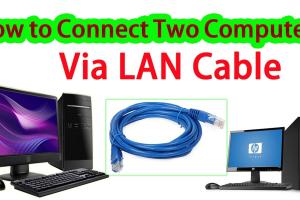Step-by-Step Guide to Connecting Your PC to a Network: A Comprehensive Approach

-
Quick Links:
- Introduction
- Types of Networks
- Hardware Needed
- Connecting to a Wired Network
- Connecting to a Wireless Network
- Configuring Network Settings
- Troubleshooting Network Issues
- Case Studies
- Expert Insights
- FAQs
Introduction
In today's digitally connected world, knowing how to connect your PC to a network is essential. Whether you're working from home or streaming your favorite shows, a stable network connection is vital. This guide will walk you through the entire process, from understanding the types of networks to troubleshooting common issues.
Types of Networks
Before diving into the connection process, let's explore the various types of networks you may encounter:
- Local Area Network (LAN): Short-distance networks, typically within a single building.
- Wide Area Network (WAN): Larger networks that may span cities or countries.
- Wireless Local Area Network (WLAN): Uses wireless technology to connect devices.
- Virtual Private Network (VPN): Secure connections over the internet, often used for remote work.
Hardware Needed
Connecting your PC to a network requires specific hardware:
- Network Interface Card (NIC): A built-in or external card that connects your PC to the network.
- Router: Directs traffic between your devices and the internet.
- Ethernet Cable (for wired connections): An essential cable to connect your PC to a router.
- Wireless Adapter (for wireless connections): Allows your PC to connect to Wi-Fi networks.
Connecting to a Wired Network
Connecting your PC to a wired network is straightforward. Follow these steps:
- Check Your NIC: Ensure your PC has a functioning NIC.
- Plug in the Ethernet Cable: Connect one end of the Ethernet cable to your PC and the other to the router.
- Power on Your Router: Ensure your router is powered and functioning.
- Verify Connection: Check for a solid green light on your NIC, indicating a connection.
Connecting to a Wireless Network
To connect your PC to a wireless network, follow these steps:
- Open Network Settings: Click on the network icon in the system tray.
- Select Wi-Fi Network: Choose your desired Wi-Fi network from the list.
- Enter Password: Input the Wi-Fi password when prompted.
- Connect: Click on the connect button. Your PC should now be connected.
Configuring Network Settings
Proper configuration of your network settings can enhance performance and connectivity:
- Access Network Settings: Go to Control Panel > Network and Internet > Network Connections.
- Change Adapter Settings: Right-click your active network and select Properties.
- Internet Protocol Version 4 (TCP/IPv4): Ensure this option is enabled for internet access.
- DNS Settings: Use automatic DNS settings or input your preferred DNS servers.
Troubleshooting Network Issues
If you experience connectivity issues, follow these troubleshooting steps:
- Restart Your PC and Router: A simple reboot can often resolve connectivity issues.
- Check Cables: Ensure all cables are properly connected and functioning.
- Run Network Troubleshooter: Use built-in Windows troubleshooting tools to diagnose problems.
- Update Network Drivers: Check for updates for your network drivers via Device Manager.
Case Studies
Real-world scenarios can provide valuable insights into the process of connecting a PC to a network:
Case Study 1: Home Office Setup
A freelance graphic designer set up a home office. They chose a wired connection for stability. By following the steps outlined in this guide, they successfully connected their PC to the router, achieving faster upload speeds for large files.
Case Study 2: Small Business Network
A small business implemented a wireless network for its employees. By configuring their Wi-Fi settings and ensuring security protocols were in place, they provided reliable internet access for all devices, enhancing productivity.
Expert Insights
Industry professionals emphasize the importance of understanding your network's requirements:
- According to tech expert John Doe, "A strong understanding of both wired and wireless connections can significantly improve your overall internet experience."
- Networking specialist Jane Smith notes, "Regularly updating your network drivers and firmware can prevent many common issues."
FAQs
1. How do I know if my PC is connected to the network?
You can check the network icon in the system tray; a connected icon indicates a successful connection.
2. What should I do if my network connection keeps dropping?
Try restarting your router and checking for interference from other devices.
3. Can I connect my PC to a wireless network without a Wi-Fi adapter?
No, your PC requires a Wi-Fi adapter to connect to wireless networks.
4. How do I find my network password?
Your network password is usually found on the router or within the router's settings interface.
5. What if my PC doesn't detect the network?
Ensure your network adapter is enabled and check that the router is broadcasting the SSID.
6. Are wired connections faster than wireless?
Generally, wired connections provide faster and more stable speeds than wireless connections.
7. How do I change my Wi-Fi network name?
Access your router's settings through a web browser and look for the SSID settings to change your network name.
8. Can I connect multiple PCs to the same network?
Yes, you can connect multiple devices to the same network, both wired and wirelessly.
9. How do I secure my wireless network?
Use WPA3 encryption, change the default password, and hide your SSID for added security.
10. What is the difference between a router and a modem?
A modem connects your home network to the internet, while a router distributes that connection to multiple devices.
Random Reads
- Create cool email address
- Create folders apps ipad home screen
- How to hide your phone number on whatsapp
- How to hide youtube subscriber count
- How to connect hdmi to tv
- How to connect hp deskjet 3050 to wireless router
- How to make a phone call
- How to make a grindstone in minecraft
- How to boot from usb in windows 7
- How to boot to command prompt